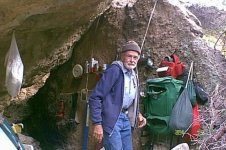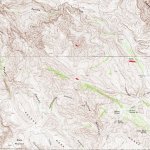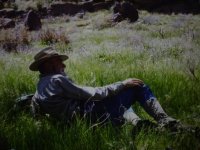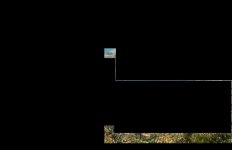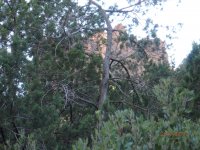Matthew Roberts
Bronze Member
One Sunday afternoon in early 1990 a man stopped at my ranch north of New River, Arizona and introduced himself as Jim Hatt.
Hatt had recently moved to Arizona from the east coast and was renting an apartment in Phoenix. He had heard of me through several Dutch Hunters in the Apache Junction area who told him I might be able to locate for him some landmarks and sites in the Tortilla Mountain area of the northern Superstition Mountains that he was looking for. Hatt was at that time unfamiliar with the mountains and trails and wanted to know the best way to find and get to some places that were pretty far off trail.
Jim stayed for dinner with the family that day and afterward we went out to my bunkhouse and looked over some of Jim’s topo maps and places he had marked on those maps. Jim told me he became interested in the Lost Dutchman Mine from his great-grandfather Earl Hatt who lived in Helena, Montana in the 1890’s and knew Gottfreid and Herman Petrasch while those two men were mining there. Jim’s gr-grandfather had a letter(s) Gottfreid Petrasch had written him after Gottfreid and Herman had gone to Arizona to hunt the Lost Dutchman Mine with Julia Thomas.
Jim said he came to Arizona to settle there and follow up on some information his gr-grandfather Hatt had learned from the Petrasch’s. He wanted me to take him into the mountains to find a place high up on Tortilla Mountain and offered a partnership 50-50 if we were to find the mine using his gr-grandfather’s information.
I was busy at the time but Jim and I finally made that trip into the mountains about 6-8 weeks later. We went in at the Tortilla Ranch in the Northeast Superstitions but instead of following the Peters Trailhead from the ranch we went straight west from the ranch and up to the head of Indian Springs Canyon. At the top of that canyon is a saddle where Gottfreid Petrasch had his camp when he worked for the Bark – Criswell Ranch. Gottfreid, Herman and even Rhinehart Petrasch all used that camp off and on for years as a base to hunt the Lost Dutchman Mine.
That camp was one of the main things Jim Hatt was looking for in the mountains. He knew it existed but didn’t know where it was located until that day. There was still at that time some old rotted rope, empty cans and pieces of junk and mining equipment in a small cubby hole back in some rocks nearby the camp that had been used by the Petrasch’s.
Jim and I camped in that saddle that night and over a night’s campfire he questioned me about some other places he was interested in, --- where they were located from Petrasch’s camp and the best way to get to them. Jim made several notes on his topo map where these places were located and how best to get there.
It struck me at the time that once Jim knew where Petrasch’s camp was located he had no more use for me. Instead of going anywhere else in the mountains the next morning Jim announced suddenly he wanted to leave the mountains and get back home right away. We packed up and headed back to the Tortilla Ranch, Jim bid me good-bye and I didn’t hear from him until almost a year later.
Out of the blue Jim called me one night at my home at New River and asked me if I would take a look at some rock samples he had taken and go back out in the mountains with him and do some geology work for him. I agreed to meet him at a restaurant in Mesa and during that meeting Jim showed me a piece of gold in Quartz he had found along an old trail North of Petrasch’s camp. Then Jim showed me some old German coins he had found in a cave not far from that trail. Jim also told me he believed he had found Jacob Waltz’s two room house in the cave where he found the German coins. Jim went on to show me a photograph of a rock landmark that appeared in a drawing allegedly made by Waltz and given to Rhinehart Petrasch. The rock landmark in Jim’s photograph was a remarkable resemblance to the Waltz drawing. Jim told me that rock was within 50 feet of his cave.
We made plans that day to go back out in the mountains. Once in the mountains we were in Petrasch’s camp on Tortilla Mountain and Jim led me down a rough brushy canyon to the North. I knew this canyon to empty into another canyon further down the mountain which eventually emptied into Tortilla Creek a mile or so east of Tortilla Flat. The canyon was full of trees and brush and closed up on you about a third of the way down. I had never gone very far down the canyon before that day.
About halfway down the canyon we came to a nice pool of water about 20 feet long, 6 feet wide and 5 feet deep. Right next to this little pool was a cave opening half hidden by trees and brush. This was Jim Hatt’s cave. The cave was large enough to stand up in and went back about 10 feet or so and had another room a little higher than the main room and much smaller. Hatt told me this was Waltz’s two room house. The cave made an excellent shelter, big enough for 2-3 people to use comfortably. It was well hidden in the trees and unless you were 50 feet from the cave you would never know it was there.
Jim had done a lot of excavating on an open hillside a short distance across from the cave, he told me he had found what he thought was some old mine tailings and he was looking for a covered mine entrance. He had moved an awful lot of rock and material. Jim asked me to look at the rock and quartz he was digging and what he believed to be gold. It didn’t take long to realize what he was digging was a quartz outcrop that a previous prospector had dug into but didn’t find anything worth pursuing.
There was some small mineralization to the outcrop but in the form of chalcopyrite and mica. No traces of gold or silver could be found anywhere near the digging. Jim had been sure he had struck gold and after the tremendous amount of time and effort he had put into the site he didn’t want to hear his work was all for nothing.
Jim was not the type of person to take defeat gracefully and he turned his disappointment and anger on me the messenger of the bad news. I told Jim that day that he was digging in a barren hillside of basalt and the place he should be looking was down canyon from his cave. The area nearby the cave showed some promise of quartz in decomposing granite and it might be worthwhile to follow the canyon down and pan every pool and trap he could find all the way to Tortilla Creek.
Jim was in no mood to listen and ordered me out of his area. I left Hatt to his digging that day and heard some time later that he had given up on the cave and was searching another area of Tortilla Mountain around an old mercury mine. About this time, I was talking with Clay Worst and Clay asked me if I wouldn’t go with him back to Hatt’s cave and see if we couldn’t find something. Clay had taken over Hatt’s cave and had set himself up a nice camp in the cave and even though he wasn’t sure Hatt’s cave was Waltz’s two room house, he felt some things fit the clues and stories of the LDM.
Clay and I made a couple of trips back into Hatt’s cave. We camped at Petrasch’s camp and in the cave itself. The cave at that time had all the comforts of home. Clay and I searched the entire area for possible mineral deposits. While digging down to bedrock in a particularly good natural trap in the canyon below Hatt’s cave, we dug and panned out a small amount of coarse gold flakes. Clay noted under his magnifier it looked as if the gold had not traveled very far and there was a distinctive black sand iron with it that was like tiny ball-bearings. We searched back up canyon and all the slopes draining into the canyon but couldn’t find a deposit from where it might have broken off. Clay thought the gold might possibly be washing into the canyon from underground during heavy rains and deposited through cracks and openings in the canyon bottom itself.
There is some good looking geology in that canyon but despite best efforts, small amounts of placer gold is all that could be recovered.
Jim Hatt eventually found out about the gold found in the canyon near his cave and went off and threatened me to stay out of his area or there would be trouble between him and I in the mountains. The truth was I had no desire to pursue anything in his area and took his threats with a grain of salt although I knew Hatt was occasionally irrational and prone to sudden fits of anger. At one time or another Jim turned on just about everyone who had befriended him and helped him first get started. When Jim was first diagnosed with cancer in November of 2010, I saw him at Goldfield one day, we talked and had lunch together and over a beer we shook hands and parted friends. That was the last time I saw Jim Hatt.
I don’t to this day know exactly what Jim Hatt really thought about the cave he found, whether he believed it was Waltz’s two room house or not. I look back to the day I took him to Petrasch’s camp at the head of Indian Springs Canyon and realize he needed to find that camp, and once he did he had information on which canyon to take from there to find that cave. Jim must have had some information from his gr-grandfather that pointed him there.
It’s been many years since I’ve been to Hatt's cave. Clay continued to use the cave for a camp and one day about 2009 a bear got in the cave and tore everything to pieces. I had seen bear tracks in that part of Tortilla Mountain before, and Mountain Lion would routinely patrol up and down those canyons. I recall dark nights laying in my bedroll listening to a cougar screaming somewhere out on Tortilla. I have been in the Superstitions with many people over the years, listened to hundreds of stories and tales and knew people who were sure they had found the Lost Dutchman Mine. Although I don’t believe Hatt’s cave was Waltz’s two room house, the cave and surrounding area has always intrigued me as one of the best mysteries of the Superstition Mountains.
Hatt’s cave is in VERY rough and remote country and no one should ever attempt to venture there without careful planning for safety and with all the proper equipment.
Hatt had recently moved to Arizona from the east coast and was renting an apartment in Phoenix. He had heard of me through several Dutch Hunters in the Apache Junction area who told him I might be able to locate for him some landmarks and sites in the Tortilla Mountain area of the northern Superstition Mountains that he was looking for. Hatt was at that time unfamiliar with the mountains and trails and wanted to know the best way to find and get to some places that were pretty far off trail.
Jim stayed for dinner with the family that day and afterward we went out to my bunkhouse and looked over some of Jim’s topo maps and places he had marked on those maps. Jim told me he became interested in the Lost Dutchman Mine from his great-grandfather Earl Hatt who lived in Helena, Montana in the 1890’s and knew Gottfreid and Herman Petrasch while those two men were mining there. Jim’s gr-grandfather had a letter(s) Gottfreid Petrasch had written him after Gottfreid and Herman had gone to Arizona to hunt the Lost Dutchman Mine with Julia Thomas.
Jim said he came to Arizona to settle there and follow up on some information his gr-grandfather Hatt had learned from the Petrasch’s. He wanted me to take him into the mountains to find a place high up on Tortilla Mountain and offered a partnership 50-50 if we were to find the mine using his gr-grandfather’s information.
I was busy at the time but Jim and I finally made that trip into the mountains about 6-8 weeks later. We went in at the Tortilla Ranch in the Northeast Superstitions but instead of following the Peters Trailhead from the ranch we went straight west from the ranch and up to the head of Indian Springs Canyon. At the top of that canyon is a saddle where Gottfreid Petrasch had his camp when he worked for the Bark – Criswell Ranch. Gottfreid, Herman and even Rhinehart Petrasch all used that camp off and on for years as a base to hunt the Lost Dutchman Mine.
That camp was one of the main things Jim Hatt was looking for in the mountains. He knew it existed but didn’t know where it was located until that day. There was still at that time some old rotted rope, empty cans and pieces of junk and mining equipment in a small cubby hole back in some rocks nearby the camp that had been used by the Petrasch’s.
Jim and I camped in that saddle that night and over a night’s campfire he questioned me about some other places he was interested in, --- where they were located from Petrasch’s camp and the best way to get to them. Jim made several notes on his topo map where these places were located and how best to get there.
It struck me at the time that once Jim knew where Petrasch’s camp was located he had no more use for me. Instead of going anywhere else in the mountains the next morning Jim announced suddenly he wanted to leave the mountains and get back home right away. We packed up and headed back to the Tortilla Ranch, Jim bid me good-bye and I didn’t hear from him until almost a year later.
Out of the blue Jim called me one night at my home at New River and asked me if I would take a look at some rock samples he had taken and go back out in the mountains with him and do some geology work for him. I agreed to meet him at a restaurant in Mesa and during that meeting Jim showed me a piece of gold in Quartz he had found along an old trail North of Petrasch’s camp. Then Jim showed me some old German coins he had found in a cave not far from that trail. Jim also told me he believed he had found Jacob Waltz’s two room house in the cave where he found the German coins. Jim went on to show me a photograph of a rock landmark that appeared in a drawing allegedly made by Waltz and given to Rhinehart Petrasch. The rock landmark in Jim’s photograph was a remarkable resemblance to the Waltz drawing. Jim told me that rock was within 50 feet of his cave.
We made plans that day to go back out in the mountains. Once in the mountains we were in Petrasch’s camp on Tortilla Mountain and Jim led me down a rough brushy canyon to the North. I knew this canyon to empty into another canyon further down the mountain which eventually emptied into Tortilla Creek a mile or so east of Tortilla Flat. The canyon was full of trees and brush and closed up on you about a third of the way down. I had never gone very far down the canyon before that day.
About halfway down the canyon we came to a nice pool of water about 20 feet long, 6 feet wide and 5 feet deep. Right next to this little pool was a cave opening half hidden by trees and brush. This was Jim Hatt’s cave. The cave was large enough to stand up in and went back about 10 feet or so and had another room a little higher than the main room and much smaller. Hatt told me this was Waltz’s two room house. The cave made an excellent shelter, big enough for 2-3 people to use comfortably. It was well hidden in the trees and unless you were 50 feet from the cave you would never know it was there.
Jim had done a lot of excavating on an open hillside a short distance across from the cave, he told me he had found what he thought was some old mine tailings and he was looking for a covered mine entrance. He had moved an awful lot of rock and material. Jim asked me to look at the rock and quartz he was digging and what he believed to be gold. It didn’t take long to realize what he was digging was a quartz outcrop that a previous prospector had dug into but didn’t find anything worth pursuing.
There was some small mineralization to the outcrop but in the form of chalcopyrite and mica. No traces of gold or silver could be found anywhere near the digging. Jim had been sure he had struck gold and after the tremendous amount of time and effort he had put into the site he didn’t want to hear his work was all for nothing.
Jim was not the type of person to take defeat gracefully and he turned his disappointment and anger on me the messenger of the bad news. I told Jim that day that he was digging in a barren hillside of basalt and the place he should be looking was down canyon from his cave. The area nearby the cave showed some promise of quartz in decomposing granite and it might be worthwhile to follow the canyon down and pan every pool and trap he could find all the way to Tortilla Creek.
Jim was in no mood to listen and ordered me out of his area. I left Hatt to his digging that day and heard some time later that he had given up on the cave and was searching another area of Tortilla Mountain around an old mercury mine. About this time, I was talking with Clay Worst and Clay asked me if I wouldn’t go with him back to Hatt’s cave and see if we couldn’t find something. Clay had taken over Hatt’s cave and had set himself up a nice camp in the cave and even though he wasn’t sure Hatt’s cave was Waltz’s two room house, he felt some things fit the clues and stories of the LDM.
Clay and I made a couple of trips back into Hatt’s cave. We camped at Petrasch’s camp and in the cave itself. The cave at that time had all the comforts of home. Clay and I searched the entire area for possible mineral deposits. While digging down to bedrock in a particularly good natural trap in the canyon below Hatt’s cave, we dug and panned out a small amount of coarse gold flakes. Clay noted under his magnifier it looked as if the gold had not traveled very far and there was a distinctive black sand iron with it that was like tiny ball-bearings. We searched back up canyon and all the slopes draining into the canyon but couldn’t find a deposit from where it might have broken off. Clay thought the gold might possibly be washing into the canyon from underground during heavy rains and deposited through cracks and openings in the canyon bottom itself.
There is some good looking geology in that canyon but despite best efforts, small amounts of placer gold is all that could be recovered.
Jim Hatt eventually found out about the gold found in the canyon near his cave and went off and threatened me to stay out of his area or there would be trouble between him and I in the mountains. The truth was I had no desire to pursue anything in his area and took his threats with a grain of salt although I knew Hatt was occasionally irrational and prone to sudden fits of anger. At one time or another Jim turned on just about everyone who had befriended him and helped him first get started. When Jim was first diagnosed with cancer in November of 2010, I saw him at Goldfield one day, we talked and had lunch together and over a beer we shook hands and parted friends. That was the last time I saw Jim Hatt.
I don’t to this day know exactly what Jim Hatt really thought about the cave he found, whether he believed it was Waltz’s two room house or not. I look back to the day I took him to Petrasch’s camp at the head of Indian Springs Canyon and realize he needed to find that camp, and once he did he had information on which canyon to take from there to find that cave. Jim must have had some information from his gr-grandfather that pointed him there.
It’s been many years since I’ve been to Hatt's cave. Clay continued to use the cave for a camp and one day about 2009 a bear got in the cave and tore everything to pieces. I had seen bear tracks in that part of Tortilla Mountain before, and Mountain Lion would routinely patrol up and down those canyons. I recall dark nights laying in my bedroll listening to a cougar screaming somewhere out on Tortilla. I have been in the Superstitions with many people over the years, listened to hundreds of stories and tales and knew people who were sure they had found the Lost Dutchman Mine. Although I don’t believe Hatt’s cave was Waltz’s two room house, the cave and surrounding area has always intrigued me as one of the best mysteries of the Superstition Mountains.
Hatt’s cave is in VERY rough and remote country and no one should ever attempt to venture there without careful planning for safety and with all the proper equipment.


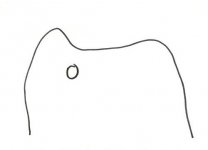
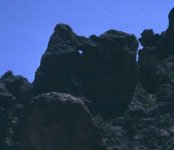
 he got very angry and that ended our association. I'm afraid, over the years, I didn't get much smarter. Jim had sent me a bunch of pictures of his location and I was not a big fan of what he was seeing. Don't know where I have stashed those pictures.
he got very angry and that ended our association. I'm afraid, over the years, I didn't get much smarter. Jim had sent me a bunch of pictures of his location and I was not a big fan of what he was seeing. Don't know where I have stashed those pictures. Despite that, when he passed I helped shape a eulogy for him. Jim had many friends and had spent countless hours exploring the Superstitions.
Despite that, when he passed I helped shape a eulogy for him. Jim had many friends and had spent countless hours exploring the Superstitions. 
